
| The purpose of this document is to give a comprehensive explanation
of how to build and use a ballista, as well as how to best plan the logistics
of moving them into battle.
The information presented here was compiled with painstaking effort by the author, and should not be re-posted in whole or in part elsewhere without the author's permission. DAoC Ballistae |

Front View of a Ballsita |
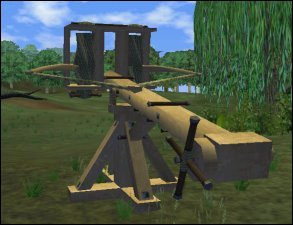
Ballista in Resting Position |
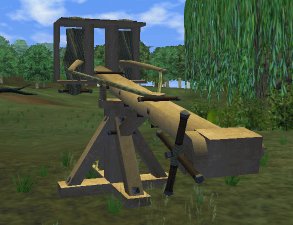
Ballista Armed for Firing (note the position of the cable) |
Component Formulas
|
|
Component |
|
|
|
Linen Cloth Squares |
|
|
Ferrite Gimbal |
|
|
|
|
|
|
Ferrite Spring Arms |
|
|
|
|
|
|
Ferrite Ballista Trigger |
|
|
|
|
|
|
Tanned Torsion Cable |
|
|
|
|
Production Costs
| Class I: Scorpion | ||
|
|
|
|
| 400 Elm Wooden Boards (Vendor) |
|
|
| 1 Ferrite Gimbal |
|
|
| 1 Ferrite Spring Arms |
|
|
| 1 Ferrite Ballista Trigger |
|
|
| 2 Tanned Torsion Cables |
|
|
|
Total Cost:
|
|
|
| Class II: Ballista | ||
|
|
|
|
| 400 Oaken Wooden Boards (Vendor) |
|
|
| 1 Ferrite Gimbal |
|
|
| 1 Ferrite Spring Arms |
|
|
| 1 Ferrite Ballista Trigger |
|
|
| 2 Tanned Torsion Cables |
|
|
|
Total Cost:
|
|
|
| Class III: Palintone | ||
|
|
|
|
| 400 Ironwood Wooden Boards (Vendor) |
|
|
| 1 Ferrite Gimbal |
|
|
| 1 Ferrite Spring Arms |
|
|
| 1 Ferrite Ballista Trigger |
|
|
| 2 Tanned Torsion Cables |
|
|
|
Total Cost:
|
|
|
| Ballista Bolt (Vendor) |
|
|
|
Albion - Caer Benowyc, in Hadrian's Wall Hibernia - Dun Crauchon, in Emain Macha Midgard - Bledmeer Faste, in Odin's Gate -Wood can be purchased in Tir Na Nog, Innis Cathaig, and at any Merchant
Keep.
Note: Many merchants sell siege components that are not usable in any
siege weapon. For example, in a frontier merchant keep you may find a "Ballista
Trigger" for sale on one vendor. This item is not usable in a ballista.
You must use a "Ferrite Ballista Trigger". Be particularly cautious of
this disparity when purchasing Ferrite Gimbals, Ballista Triggers, and
Spring Arms, since these must be made of ferrite, and "Gimbal",
"Ballista Trigger", and "Spring Arms", while useless, are sold by NPC merchants.
Weight Considerations |
Ballista Component Weights
|
|
|
|
| Tanned Torsion Cables (2) |
|
|
| Ferrite Gimbal |
|
|
| Ferrite Spring Arms |
|
|
| Ferrite Ballista Trigger |
|
|
| Wooden Boards (400) |
|
|
|
Total Ballista Weight:
|
|
|
| Ammunition | ||
| Ballista Bolt x30 |
|
|
|
Total Package Total:
|
|
| Based on these figures, 1 ballista weighs 330 lbs, regardless of the
wood used, and an additional 60 lbs for the ammunition. Here are some guidelines
to use so that your ballista arrives at the keep with all of its components.
1) Use as few a number of people as possible to transport components. 2) When allocating weight among individuals, never give them more weight they they can carry, unencumbered, while self-buffed. Example: Garek is a L50 warden with 160 strength. Self-buffed (w/ L50 strength buff, +50 strength) his strength is 211. Check your encumberance, self-buffed, to know how much you can carry. Keep in mind your armor and weapons count against your encumberance too, so be sure to look at your encumberance and not only your strength. With 211 str the max encumberance is 210, and Garek carries approximately 50 pounds of equipment (tools, weapons, armor, arrows, etc.) so he can carry 160 lbs of equipment. Although Garek's strength is much higher with a druid's strength/constitution buff, he does not carry more than 160 lbs of siege equipment. The reason for this is, if someone is strength buffed and their buffer disconnects, they will be overloaded, and likely unable to move. If you come into contact with the enemy while moving to your objective, and the strength buffer is killed, overloaded party members will become rooted by their encumberance, and easy pray to enemy troops. Wardens, Bards, and Druids are ideal choices for carrying siege equipment for their self-buffed capacity, with Heroes, Blademasters, and Champions being a close second for their raw strength. Many members of these classes are also often Firbolgs, which gives them an even greater weight capacity. |
|
Allocating parts for one ballista across three carriers should look
something like:
|
|
Make sure you have a sewing kit, smithing hammer, and planing tool on you when attempting to build any siege weapon! To physically emplace a ballista, you need to keep in mind the areas you want to bombard. Keep in mind that the ballista is an area effect weapon, so in RvR you will want to avoid hitting NPC spawns. You need to be particularly mindful of the minimum range of the ballista. Because it uses indirect fire, it does not require line of sight, but it uses the physics of a parabolic arc when firing, so your target must be a set range away to be fired on. The minimum range of a ballista is approximately 1500 units, and the maximum range is approximately 3500 units. Using /loc, you can estimate these distances. In defending a keep, you will need to place the ballista in the lord's tower or along the back wall in order to deliver fire on the gates. In the offense ballista can be used to deliver firepower on a defended keep, but you will need an enemy targeted, or a stealther to spot for you. Do not build the ballista too close to the keep being attacked or it will be useless, and expect to have heavy counterbattery fire delivered on you if you deploy a weapon in a siege - it is very easy to target siege weapons outside the keep, but very hard to attack them inside. The equipment carriers pass the engineer the full list of components
once the engineer is standing in the spot the weapon needs to be built.
The weight of all the components will overload the engineer to the point
that he will be unable to move at all. Be mindful of this if the engineer
is killed before construction is complete! If the engineer needs ressurecting
before he has built the weapon, the resser needs to stand exactly
where the engineer died, so that the engineer will be in the correct spot
for construction. If you ressurect the engineer 50 feet away from where
he died, he will not be able to walk to the correct spot, and all the equipment
on him will need to be offloaded so he can move, creating a waste of critical
time.
|
|
|
|
|
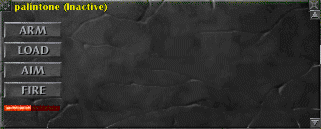 |
| To bring the ballista into play, start by selecting a point target with your cursor, or by using F8 and push the button marked "Aim". The aiming sequence takes 5 seconds to complete. Note that you can target inanimate objects as well, such as a keep door. When you hit Aim, the ballista aims at the x, y, and z coordinates your target occupied at the moment aim was pushed like a snapshot. If you aimed at a mobile target, the ballista will not track the target, you will need to re-aim it. Because of how the aiming system works, one useful trick is to group with a Nightshade, have them move while stealthed to the spot you need to fire on, then Aim at them. They can leave move elsewhere, but your weapon is now ready to bombard. This approach is most effective when trying to bombard enemy siege weapons inside a keep, from outside it. |
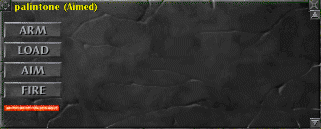 |
| Now, hit the button marked "Arm" on the control window. The timer bar will begin to fill. It takes 20 seconds to arm a ballista. Note that the timer bar takes less than than 20 seconds to fill, so do not rely on the bar to gauge when the ballista is ready. When the Arm button is pushed, you will see the Ballista's cable draw back and the gears will turn. |
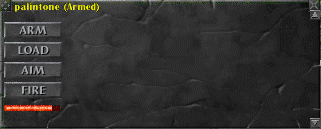 |
| Now that the weapon itself has been prepared using the arming sequence, you need to prepare the ammunition. Take 1 ballista bolt from your inventory and drop it directly onto the ballista. You will see the ballista bolt appear on the control panel window. Now hit the button labeled "Load". It takes 5 seconds to complete the loading sequence. Although you can load more than one bolt at the same time, I recommend not doing so, since bolts tend to get bugged and are lost from inventory but become unfireable. |
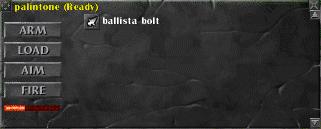 |
After the 5 second loading period has elapsed, press the "Fire" button
in the window, and the ballista will visually rock back from firing the
bolt. You will also receive a melee damage report of the bolt's damage,
with the highest damage occuring at the center of the impact area, and
the least damage at the fringe of the blast's effect radius.
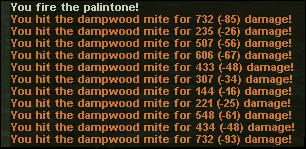
|
|
Macro 1 - Siegecraft menu Palintone icon
Now for the construction:
And if the ballista requires repairs,
|
|
It is essential that you watch the ballista's health bar to avoid having
it decay before you are done. Ballistas decay two different ways:
Presently siege weapon repairs only check the repairer's Woodworking skill using a pass/ fail skill check. If successful, you will repair the ballista's hit points to full. These repairs cost no resources, and do not require any wood or other material to attempt. If you fail your repair attempt, simply try again. |
|
|
|
|